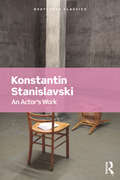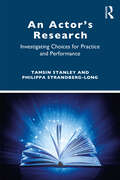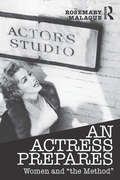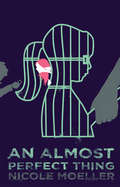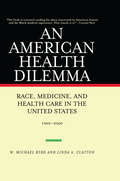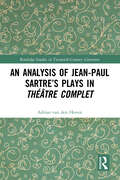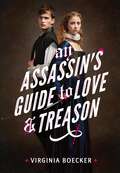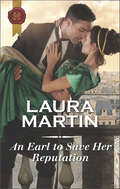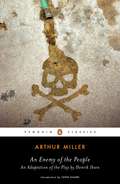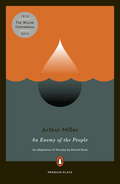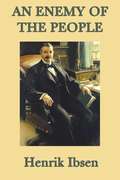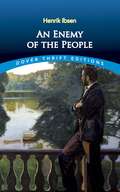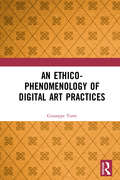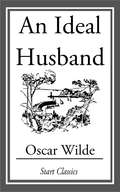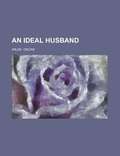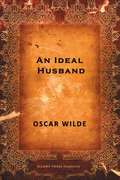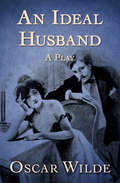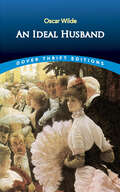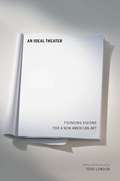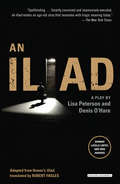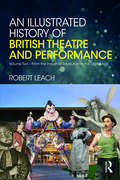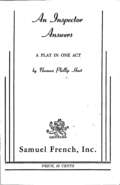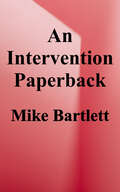- Table View
- List View
An Actor's Work: A Student's Diary (Routledge Classics)
by Konstantin StanislavskiStanislavski’s ‘system’ has dominated actor-training in the West since his writings were first translated into English in the 1920s and 30s. His systematic attempt to outline a psycho-physical technique for acting single-handedly revolutionized standards of acting in the theatre. Until now, readers and students have had to contend with inaccurate, misleading and difficult-to-read English-language versions. Some of the mistranslations have resulted in profound distortions in the way his system has been interpreted and taught. At last, Jean Benedetti has succeeded in translating Stanislavski’s huge manual into a lively, fascinating and accurate text in English. He has remained faithful to the author's original intentions, putting the two books previously known as An Actor Prepares and Building A Character back together into one volume, and in a colloquial and readable style for today's actors. The result is a major contribution to the theatre, and a service to one of the great innovators of the twentieth century. This Routledge Classics edition includes a new Foreword by the director Richard Eyre.
An Actor’s Research: Investigating Choices for Practice and Performance
by Tamsin Stanley Philippa Strandberg-LongAn Actor’s Research: Investigating Choices for Practice and Performance presents an accessible and highly practical guide to the research approaches required of the actor. It aims to establish the precision and rigour of the actor’s craft that is intrinsic to a compelling acting performance, explore a range of research activities surrounding and emerging from practical work in the studio, and enable the actor to evolve a multifaceted skillset in researching for performance. The chapters focus on different research areas such as the self, character, relationships, circumstance, and context, providing accessible and practical guidance to developing a personal research practice. Each aspect is explained and engaged with as practice, rather than study – offering helpful hints and advising against common pitfalls – ultimately enabling the actor to locate the necessary knowledge to shape and inform their performance in both text-based and devised scenarios. Additionally, as the actor’s self is a personal instrument that is drawn on in terms of expression, impulses, and imagination; the self also becomes a source for creative appraisal and research. This book therefore offers comprehensive advice and strategies for self-evaluation and reflection, connecting research investigation with self-exploration in making expressive performance choices, making it a practice highly applicable to the actor’s needs. An Actor’s Research closely follows the training actor’s needs in terms of performance-based research; however, its practical research activities for text and character creation and strategies for the development of critical thinking and self-reflective skills support the ongoing development of the actor and their craft in both training and professional circumstances.
An Actress Prepares: Women and "the Method"
by Rosemary Malague'Every day, thousands of women enter acting classes where most of them will receive some variation on the Stanislavsky-based training that has now been taught in the U.S. for nearly ninety years. Yet relatively little feminist consideration has been given to the experience of the student actress: What happens to women in Method actor training?' An Actress Prepares is the first book to interrogate Method acting from a specifically feminist perspective. Rose Malague addresses "the Method" not only with much-needed critical distance, but also the crucial insider's view of a trained actor. Case studies examine the preeminent American teachers who popularized and transformed elements of Stanislavsky’s System within the U.S.—Strasberg, Adler, Meisner, and Hagen— by analyzing and comparing their related but distinctly different approaches. This book confronts the sexism that still exists in actor training and exposes the gender biases embedded within the Method itself. Its in-depth examination of these Stanislavskian techniques seeks to reclaim Method acting from its patriarchal practices and to empower women who act. 'I've been waiting for someone to write this book for years: a thorough-going analysis and reconsideration of American approaches to Stanislavsky from a feminist perspective ... lively, intelligent, and engaging.' – Phillip Zarrilli, University of Exeter 'Theatre people of any gender will be transformed by Rose Malague’s eye-opening study An Actress Prepares... This book will be useful to all scholars and practitioners determined to make gender equity central to how they hone their craft and their thinking.' – Jill Dolan, Princeton University
An Almost Perfect Thing
by Nicole MoellerGreg is a once-respected journalist searching for a high-profile story that will help revive his career. Chloe is the missing girl he wrote about six years earlier who has just returned home to a world she no longer recognizes. Instead of leading police to her captor, Chloe turns to Greg to share her story. Unfortunately for him, Chloe won't provide names or locations, and instead dictates exactly how the story should be told. But Chloe has become an international celebrity—both respected and scrutinized by the public—and they all want to know, who is her kidnapper? Why is she protecting him? When Greg begins to question whether truth and fiction have collided, he takes matters into his own hands, in spite of the drastic consequences. Even if that means coming face to face with Chloe's abductor. Inspired by the story of Natascha Kampusch, An Almost Perfect Thing is a multi-perspective thriller about possession and desire, the need to own our stories, and our "right" to the truth.
An American Health Dilemma: Race, Medicine, and Health Care in the United States 1900-2000
by W. Michael Byrd Linda A. ClaytonFirst published in 2002. An American Health Dilemma is the story of medicine in the United States from the perspective of people who were consistently, officially mistreated, abused, or neglected by the Western medical tradition and the US health-care system. It is also the compelling story of African Americans fighting to participate fully in the health-care professions in the face of racism and the increased power of health corporations and HMOs. This tour-de-force of research on the relationship between race, medicine, and health care in the United States is an extraordinary achievement by two of the leading lights in the field of public health. Ten years out, it is finally updated, with a new third volume taking the story up to the present and beyond, remaining the premiere and only reference on black public health and the history of African American medicine on the market today. No one who is concerned with American race relations, with access to and quality of health care, or with justice and equality for humankind can afford to miss this powerful resource.
An Analysis of Jean-Paul Sartre’s Plays in Théâtre complet (Routledge Studies in Twentieth-Century Literature)
by Adrian van den HovenAn Analysis of Jean-Paul Sartre’s Plays in Théâtre complet is the first volume to propose a critical analysis of all of Jean-Paul Sartre’s plays as published in the Bibliothèque de la Pléiade, Paris, Gallimard, 2005. Viewing the plays in the context of Sartre’s philosophy, his prose writings and works by other philosophers, novelists, and playwrights, this comprehensive volume is essential reading for students of French literature, theatre, and existentialist philosophy.
An Assassin's Guide to Love and Treason
by Virginia BoeckerPhilippa Gregory meets Mr. and Mrs. Smith in this witty and thrilling action-adventure novel of star-crossed assassins in Elizabethan England. <P><P>When Lady Katherine's father is killed for being an illegally practicing Catholic, she discovers treason wasn't the only secret he's been hiding: he was also involved in a murder plot against the reigning Queen Elizabeth I. With nothing left to lose, Katherine disguises herself as a boy and travels to London to fulfill her father's mission, and to take it one step further--kill the queen herself. <P><P>Katherine's opportunity comes in the form of William Shakespeare's newest play, which is to be performed in front of Her Majesty. But what she doesn't know is that the play is not just a play. It's a plot to root out insurrectionists and destroy the rebellion once and for all.The mastermind behind this ruse is Toby Ellis, a young spy for the queen with secrets of his own. When Toby and Katherine are cast opposite each other as the play's leads, they find themselves inexplicably drawn to one another. But the closer they grow, the more precarious their positions become. And soon they learn that star-crossed love, mistaken identity, and betrayal are far more dangerous off the stage than on.
An Earl to Save Her Reputation (Mills And Boon Historical Ser.)
by Laura MartinA convenient betrothal“It will save us both from scandal.”Widowed three times over, Lady Anna Fortescue is used to ignoring the wagging tongues of the ton. After finding herself in a compromising position with handsome bachelor Lord Harry Edgerton, to avoid scandal she ends up engaged again. The arrangement may be one of convenience, but as Anna finds herself unable to resist Harry’s charms, she realizes the betrothal may have its benefits…
An Enemy of the People
by Arthur MillerWhen Dr. Stockmann discovers that the water in the small Norwegian town in which he is the resident physician has been contaminated, he does what any responsible citizen would do: reports it to the authorities. But Stockmann's good deed has the potential to ruin the town's reputation as a popular spa destination, and instead of being hailed as a hero, Stockmann is labeled an enemy of the people. Arthur Miller's adaptation of Henrik Ibsen's classic drama is a classic in itself, a penetrating exploration of what happens when the truth comes up against the will of the majority. This edition includes Arthur Miller's preface and an introduction by John Guare. For more than seventy years, Penguin has been the leading publisher of classic literature in the English-speaking world. With more than 1,700 titles, Penguin Classics represents a global bookshelf of the best works throughout history and across genres and disciplines. Readers trust the series to provide authoritative texts enhanced by introductions and notes by distinguished scholars and contemporary authors, as well as up-to-date translations by award-winning translators.
An Enemy of the People
by Arthur Miller John GuareWhen Dr. Stockmann discovers that the water in the small Norwegian town in which he is the resident physician has been contaminated, he does what any responsible citizen would do: reports it to the authorities. But Stockmann's good deed has the potential to ruin the town's reputation as a popular spa destination, and instead of being hailed as a hero, Stockmann is labeled an enemy of the people. Arthur Miller's adaptation of Henrik Ibsen's classic drama is a classic in itself, a penetrating exploration of what happens when the truth comes up against the will of the majority. This edition includes Arthur Miller's preface and an introduction by John Guare.For more than seventy years, Penguin has been the leading publisher of classic literature in the English-speaking world. With more than 1,700 titles, Penguin Classics represents a global bookshelf of the best works throughout history and across genres and disciplines. Readers trust the series to provide authoritative texts enhanced by introductions and notes by distinguished scholars and contemporary authors, as well as up-to-date translations by award-winning translators.From the Trade Paperback edition.
An Enemy of the People
by Henrik Ibsen Arthur Miller<P>When Dr. Stockmann discovers that the water in the small Norwegian town in which he is the resident physician has been contaminated, he does what any responsible citizen would do: reports it to the authorities. <P>But Stockmann's good deed has the potential to ruin the town's reputation as a popular spa destination, and instead of being hailed as a hero, Stockmann is labeled an enemy of the people. <P>Arthur Miller's adaptation of Henrik Ibsen's classic drama is a classic in itself, a penetrating exploration of what happens when the truth comes up against the will of the majority. This edition includes Arthur Miller's preface and an introduction by John Guare.
An Enemy of the People
by Henrick IbsenAn Enemy of the People addresses the irrational tendencies of the masses, and the hypocritical and corrupt nature of the political system that they support. It is the story of one brave man's struggle to do the right thing and speak the truth in the face of extreme social intolerance.
An Enemy of the People: A Play In Five Acts (Dover Thrift Editions Ser.)
by Henrik IbsenWidely regarded as one of the foremost dramatists of the nineteenth century, Norwegian playwright Henrik Ibsen (1828-1906) brought the social problems and ideas of his day to center stage. Creating realistic plays of psychological conflict that emphasized character over cunning plots, he frequently inspired critical objections because his dramas deemed the individual more important than the group.In this powerful work, Ibsen places his main characters, Dr. Thomas Stockman, in the role of an enlightened and persecuted minority of one confronting an ignorant, powerful majority. When the physician learns that the famous and financially successful baths in his hometown are contaminated, he insists they be shut down for expensive repairs. For his honesty, he is persecuted, ridiculed, and declared an "enemy of the people" by the townspeople, included some who have been his closest allies.First staged in 1883, An Enemy of the People remains one of the most frequently performed plays by a writer considered by many the "father of modern drama." This easily affordable edition makes available to students, teachers, and general readers a major work by one of the world's great playwrights.
An Ethico-Phenomenology of Digital Art Practices
by Giuseppe TorreDigital art practitioners work under the constant threat of a medium – the digital – that objectifies the self and depersonalises artistic identities. If digital technology is a pharmakon in that it can be either cure or poison, with regard to digital art practices the digital may have in fact worked as a placebo that has allowed us to push back the date in which the crisis between digital and art will be given serious thought. This book is hence concerned with an analysis of such a relationship and proposes their rethinking in terms of an ethico-phenomenological practice informed by an in-depth understanding of the digital medium. Giuseppe Torre engages with underground cultures such as Free and Libre Open Source Software (FLOSS) and its ties with art discourse. The discussion is informed by various philosophical discourses and media theories, with a focus on how such ideas connect back to the existing literature in performance studies. Replete with examples of artwork and practices, this book will be of great interest to students and scholars of theatre and performance studies, art and technology.
An Ideal Husband
by Oscar WildeWilde's scintillating drawing-room comedy revolves around a blackmail scheme that forces a married couple to reexamine their moral standards. A supporting cast of young lovers, society matrons, and a formidable femme fatale exchange sparkling repartee, keeping the action of the play at a lively pace.
An Ideal Husband
by Oscar WildeAn Ideal Husband is an 1895 comedic stage play by Oscar Wilde which revolves around blackmail and political corruption, and touches on the themes of public and private honour. The action is set in London, in "the present", and takes place over the course of twenty-four hours. <P> <P> "Sooner or later," Wilde notes, "we shall all have to pay for what we do." But he adds that, "No one should be entirely judged by their past." Together with The Importance of Being Earnest, it is often considered Wilde's dramatic masterpiece. After Earnest, it is his most popularly produced play.
An Ideal Husband: A Play
by Oscar WildeSecrets and political intrigue threaten to destroy the marriage of Sir Robert and Lady Chiltern. Believing her husband to be "ideal," Lady Chiltern is unwilling to accept that their life has been built on a shady financial deal in Sir Robert's past, and that Sir Robert's mistakes are about to be made public by Mrs. Cheveley. Only the intercession of Lord Goring can bring a halt to Mrs. Cheveley's schemes and reconcile Lady Chiltern with her ideal husband.
An Ideal Husband: A Play
by Oscar WildeThe classic comedic play of blackmail and political corruption from a master dramatist. A blackmail scheme forces a married couple to reexamine their moral standards—providing, along the way, a wry commentary on the rarity of politicians who can claim to be ethically pure. With a supporting cast of young lovers, society matrons, an overbearing father, and a formidable femme fatale exchanging nonstop sparkling repartee, Oscar Wilde&’s classic play moves along at a lively pace. Like most of Wilde&’s works, this scintillating drawing-room comedy is wise, well constructed, and deeply satisfying. An instant success upon its 1895 debut, An Ideal Husband continues to delight audiences over one hundred years later with its wit, urbanity, and timeless sophistication. This ebook has been professionally proofread to ensure accuracy and readability on all devices.
An Ideal Husband: A Play (Dover Thrift Editions: Plays Ser.)
by Oscar WildeAlthough Oscar Wilde (1854-1900) created a wide range of poetry, essays, and fairy tales (and one novel) in his brief, tragic life, he is perhaps best known as a dramatist. His witty, clever drama, populated by brilliant talkers skilled in the art of riposte and paradox, are still staples of the theatrical repertoire.An Ideal Husband revolves around a blackmail scheme that forces a married couple to reexamine their moral standards -- providing, along the way, a wry commentary on the rarity of politicians who can claim to be ethically pure. A supporting cast of young lovers, society matrons, an overbearing father, and a formidable femme fatale continually exchange sparkling repartee, keeping the play moving at a lively pace.ike most of Wilde's plays, this scintillating drawing-room comedy is wise, well-constructed, and deeply satisfying. An instant success at its 1895 debut, the play continues to delight audiences over one hundred years later. An Ideal Husband is a must-read for Wilde fans, students of English literature, and anyone delighted by wit, urbanity, and timeless sophistication.
An Ideal Theater
by Todd LondonAn Ideal Theater is a wide-ranging, inspiring documentary history of the American theatre movement as told by the visionaries who goaded it into being. This anthology collects over forty essays, manifestos, letters and speeches that are each introduced and placed in historical context by the noted writer and arts commentator, Todd London, who spent nearly a decade assembling this collection. This celebration of the artists who came before is an exhilarating look backward, as well as toward the future, and includes contributions from:Jane Addams William Ball Julian Beck Herbert Blau Angus Bowmer Bernard Bragg Maurice Browne Robert Brustein Alison Carey Joseph Chaikin Harold Clurman Dudley Cocke Alice Lewisohn Crowley Gordon Davidson R. G. Davis Doris Derby W. E. B. Du Bois Zelda Fichandler Hallie Flanagan Eva Le Gallienne Robert E. Gard Susan Glaspell André Gregory Tyrone Guthrie John Houseman Jules Irving Margo Jones Frederick H. Koch Lawrence Langner W. McNeil Lowry Charles Ludlam Judith Malina Theodore Mann Gilbert Moses Michaela O'Harra John O'Neal Joseph Papp Robert Porterfield José Quintero Bill Rauch Bernard Sahlins Richard Schechner Peter Schumann Maurice Schwartz Gary Sinise Ellen Stewart Lee Strasberg Luis Miguel Valdez Nina Vance Douglas Turner WardAs well as the founding visions of theatres from across the country:The Actors Studio The Actor's Workshop Alley Theatre American Conservatory Theater American Repetory Theater Arena Stage Barter Theatre Bread and Puppet Theater The Carolina Playmakers The Chicago Little Theater Circle in the Square Theatre The Civic Repertory Theatre Cornerstone Theater Company The Federal Theatre Project Ford Foundation Program in Humanities and the Arts The Free Southern Theater The Group Theatre The Hull-House Dramatic Association KRIGWA Players The Living Theatre La MaMa Experimental Theatre Club The Mark Taper Forum The Mercury Theatre Minnesota Theater Company (Guthrie Theater) The National Theatre of the Deaf The Negro Ensemble Company The Negro Theatre Project, Federal Theatre Project The Neighborhood Playhouse New Dramatists The New York Shakespeare Festival The Open Theater Oregon Shakespeare Festival The Performance Group The Provincetown Players The Repertory Theater of Lincoln Center The Ridiculous Theatrical Company Roadside Theater The San Francisco Mime Troupe The Second City Steppenwolf Theatre Company El Teatro Campesino Theater '47 The Theatre Guild The Theatre of the Living Arts The Washington Square Players The Wisconsin Idea Theater Yale Repertory Theatre The Yiddish Art TheatreTodd London is in his 18th season as artistic director of New Dramatists, the nation's oldest center for the creative and professional development of American playwrights. In 2009 Todd became the first recipient of Theatre Communications Group's (TCG) Visionary Leadership Award for "an individual who has gone above and beyond the call of duty to advance the theater field as a whole, nationally and/or internationally." He's the author of The Importance of Staying Earnest: Writings from Inside the American Theatre, 1988-2013 (NoPassport Press), Outrageous Fortune: The Life and Times of the New American Play (with Ben Pesner, Theatre Development Fund), The Artistic Home (TCG), and The World's Room, a novel (Steerforth Press), among others. His column, "A Lover's Guide to American Playwrights," tributes to contemporary
An Iliad
by Lisa Peterson Denis O'HareMasterfully adapted by Lisa Peterson and Denis O'Hare From Robert Fagles's acclaimed translation, An Iliad telescopes Homer's Trojan War epic into a gripping monologue that captures both the heroism and horror of war. Crafted around the stories of Achilles and Hector, in language that is by turns poetic and conversational, An Iliad brilliantly refreshes this world classic. What emerges is a powerful piece of theatrical storytelling that vividly drives home the timelessness of mankind's compulsion toward violence.
An Iliad
by Lisa Peterson Denis O'HareMasterfully adapted by Lisa Peterson and Denis O’Hare From Robert Fagles’s acclaimed translation, An Iliad telescopes Homer’s Trojan War epic into a gripping monologue that captures both the heroism and horror of war. Crafted around the stories of Achilles and Hector, in language that is by turns poetic and conversational, An Iliad brilliantly refreshes this world classic. What emerges is a powerful piece of theatrical storytelling that vividly drives home the timelessness of mankind’s compulsion toward violence.
An Illustrated History of British Theatre and Performance: Volume Two - From the Industrial Revolution to the Digital Age
by Robert LeachAn Illustrated History of British Theatre and Performance chronicles the history and development of theatre from the Roman era to the present day. As the most public of arts, theatre constantly interacted with changing social, political and intellectual movements and ideas, and Robert Leach’s masterful work restores to the foreground of this evolution the contributions of women, gay people and ethnic minorities, as well as the theatres of the English regions, and of Wales and Scotland. Highly illustrated chapters trace the development of theatre through major plays from each period; evaluations of playwrights; contemporary dramatic theory; acting and acting companies; dance and music; the theatre buildings themselves; and the audience, while also highlighting enduring features of British theatre, from comic gags to the use of props. Continuing on from the Enlightenment, Volume Two of An Illustrated History of British Theatre and Performance leads its readers from the drama and performances of the Industrial Revolution to the latest digital theatre. Moving from Punch and Judy, castle spectres and penny showmen to Modernism and Postdramatic Theatre, Leach’s second volume triumphantly completes a collated account of all the British Theatre History knowledge anyone could ever need.
An Inspector Answers
by Norman Phillip HartMystery / 3m, 2f / Interior / The play opens with the seemingly innocent disappearance of Lady Fitzbuttress whose husband, Sir Reginald, is tricked into confessing to her murder by the implacable Inspector from Scotland Yard. From then on, the plot twists and turns as Reginald plans to take his wife's fortune and run off with his mistress. The Inspector, who of course "knows too much," is duly shot. But bodies fall and come to life again as intrigue upon intrigue is revealed. Lady Fitzbuttress reappears. Reginald's mistress turns out to be his wife's cousin after the family inheritance, and the play ends with a "police bust" by one other than the fellow who master minded the whole "fiendishly clever" plot in the first place.
An Intervention
by Mike BartlettA touching, funny play about what happens when you hate your best friend. One of them went on the anti-war protest, shouted their lungs out, then got horrendously and staggeringly drunk. The other stayed at home, watched TV for a bit, and thought about the future. <p><p>Mike Bartlett's play An Intervention premiered at the Watford Palace Theatre in April 2014, in a co-production with Paines Plough.
